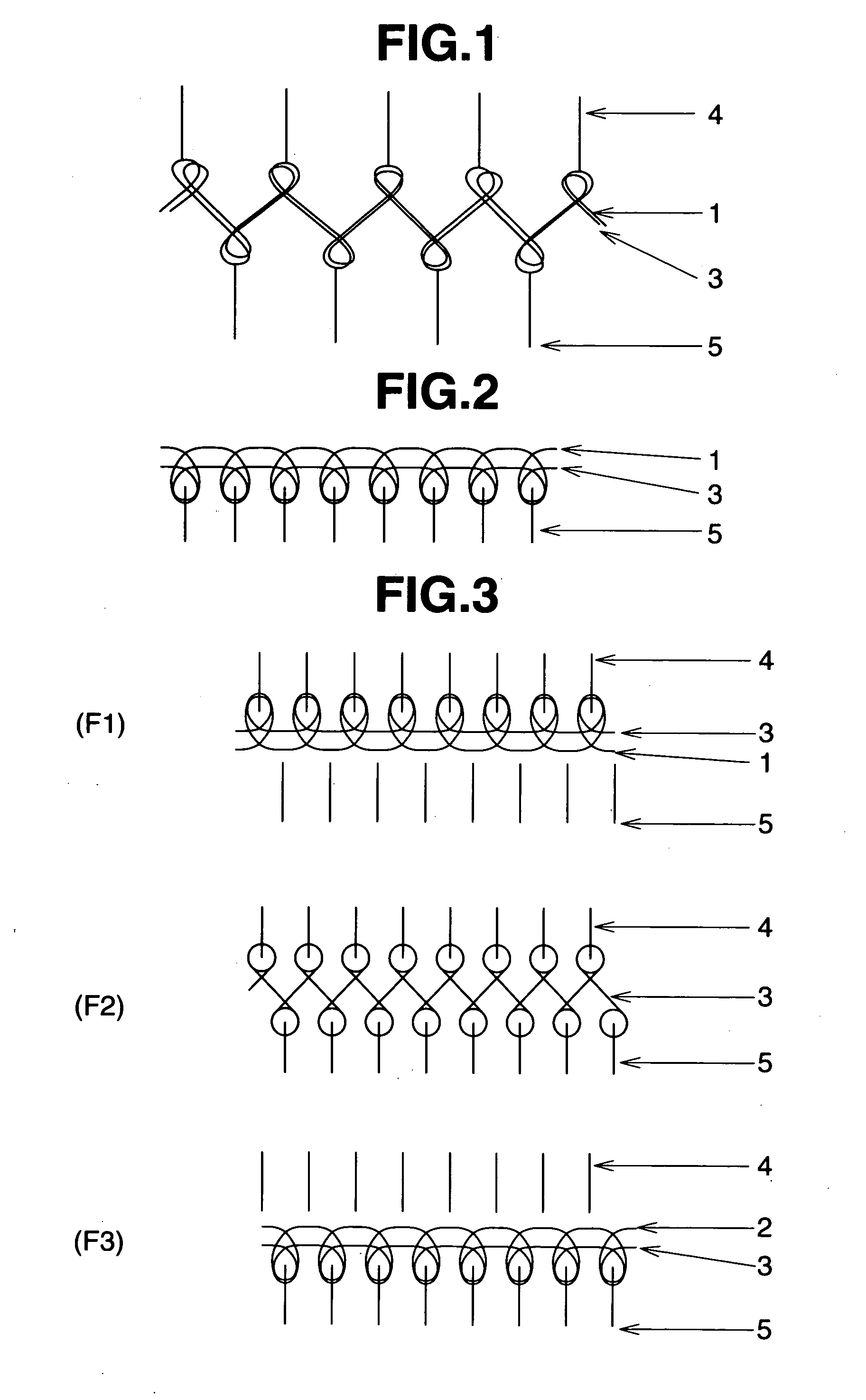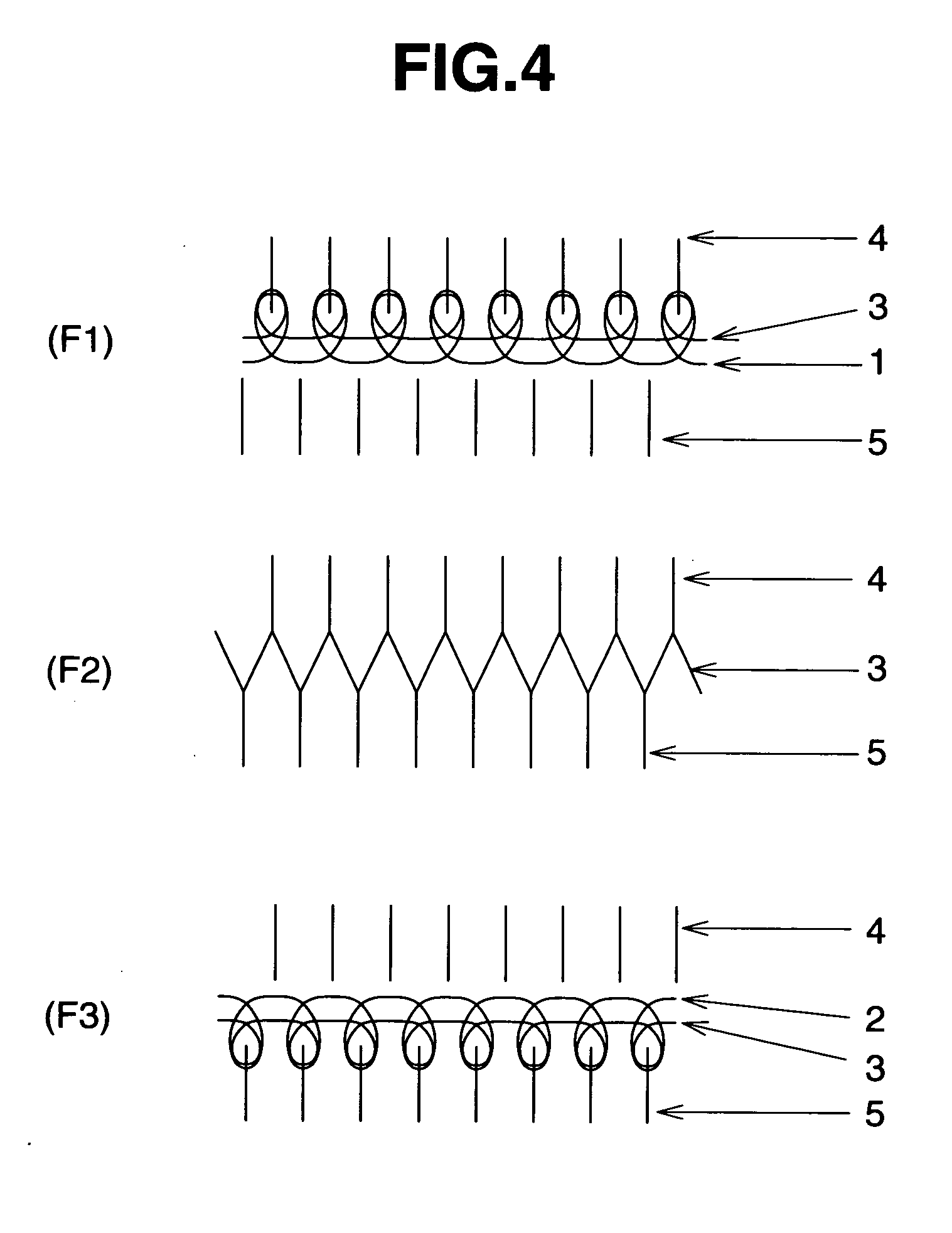Weft Knitted Fabric Including Polyurethane Elastomer Fiber and Process for Producing the Same
a technology of polyurethane elastomer fibers and weft knitted fabrics, which is applied in the field of polyurethane elastomeric filaments containing blended weft knitted fabrics, can solve the problems of weft knitted fabrics deformation and loss of uniformity, deformation, deformation, etc., and achieve excellent extensibility and recovery, and retain extensibility and recovery. effect of extension
- Summary
- Abstract
- Description
- Claims
- Application Information
AI Technical Summary
Benefits of technology
Problems solved by technology
Method used
Image
Examples
example 1
[Production of Highly Fusible, Alkali-Resistant Polyurethane Elastomeric Filaments]
[0063] A reactor sealed with nitrogen and equipped with a 80° C. warm-water jacket was charged with 25 parts of 4,4′-diphenylmethane diisocyanate (MDI) as the diisocyanate, following which 100 parts of polytetramethylene ether glycol (PTMG) having a number-average molecular weight of 2,000 was added under stirring as the polymer diol. After one hour of reaction, 27.6 parts of 1,4-butanediol was added as the low-molecular-weight diol, thereby forming a dihydroxy-terminated prepolymer.
[0064] In a parallel operation, a nitrogen-sealed 80° C. reactor was charged with 47.4 parts of MDI as the diisocyanate and 2.2 parts of a mixture composed of an ultraviolet absorber (2-(3,5-di-t-amyl-2-hydroxyphenyl)-benzotriazole: 20%), an antioxidant (3,9-bis(2-(3-(3-t-butyl-4-hydroxy-5-methylphenyl)propionyloxy)-1,1-dimethylethyl)-2,4,8,10-tetraoxaspiro[5.5]undecane: 50%) and a light stabilizer (bis(2,2,6,6-tetrameth...
example 2
[0110] Using highly fusible, alkali-resistant polyurethane elastomeric filaments of the same type as in Example 1, a knit fabric was produced on a circular rib knitting machine (needle bed diameter, 30 inches; 22-gauge; 60 feeders) based on the fabric structure depicted in FIG. 3. Shown in FIG. 3 are a 100% cotton staple yarn 1 having a yarn count of 80, a 78 dtex 24 filament false-twisted nylon yarn 2, the highly fusible, alkali-resistant polyurethane elastomeric filament 3, dial needles 4, cylinder needles 5, and yarn feeders F1 to F3. The knit-in lengths for the respective yarns were set at 30.0 cm each for the cotton yarn 1 and the nylon yarn 2, and 22.0 cm for the polyurethane elastomeric filament 3.
[0111] In this knit structure, the cotton yarn 1 and the polyurethane elastomeric filament 3 were fed by feeder F1 in a plating relationship and knit stitched on all of the dial needles 4; the polyurethane elastomeric filament 3 was fed by feeder F2 and knit stitched on all of the ...
example 3
[0114] Referring to the knit fabric structure shown in FIG. 4, polyurethane elastomeric filament 3 was fed from feeder F2 and tuck stitched on all of the dial needles 4 and all of the cylinder needles 5, aside from which a center yarn-containing reversible knit structure was constructed in the same way as in Example 2, then treated and tested. The results are shown in Table 2.
PUM
| Property | Measurement | Unit |
|---|---|---|
| melting point | aaaaa | aaaaa |
| melting point | aaaaa | aaaaa |
| melting point | aaaaa | aaaaa |
Abstract
Description
Claims
Application Information
 Login to View More
Login to View More - R&D
- Intellectual Property
- Life Sciences
- Materials
- Tech Scout
- Unparalleled Data Quality
- Higher Quality Content
- 60% Fewer Hallucinations
Browse by: Latest US Patents, China's latest patents, Technical Efficacy Thesaurus, Application Domain, Technology Topic, Popular Technical Reports.
© 2025 PatSnap. All rights reserved.Legal|Privacy policy|Modern Slavery Act Transparency Statement|Sitemap|About US| Contact US: help@patsnap.com



